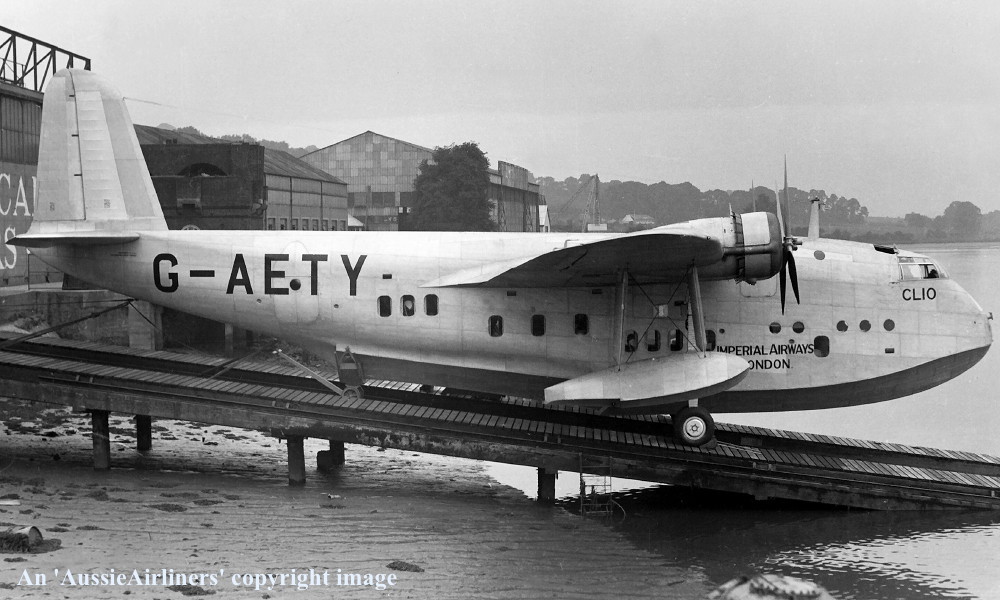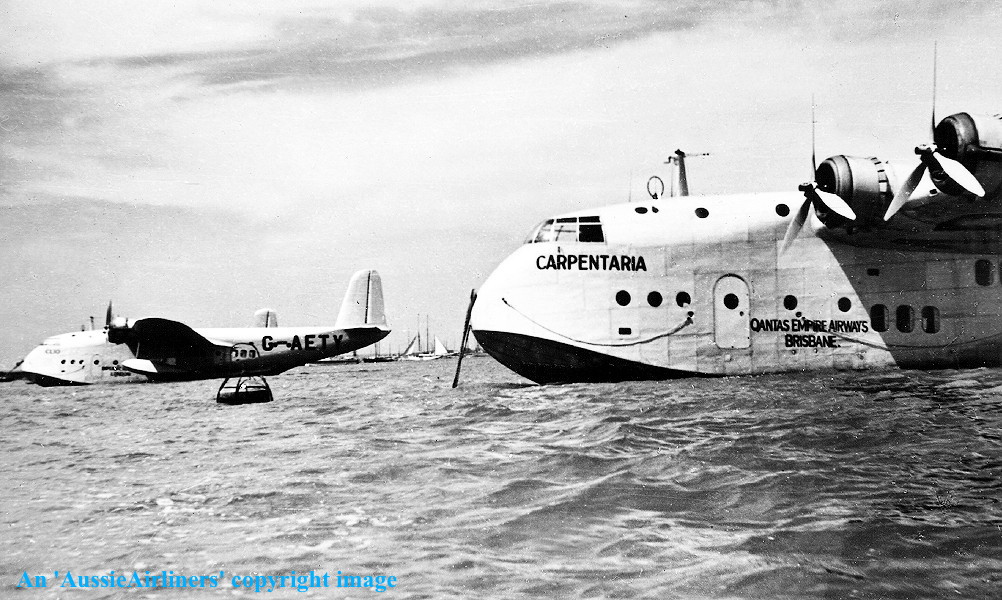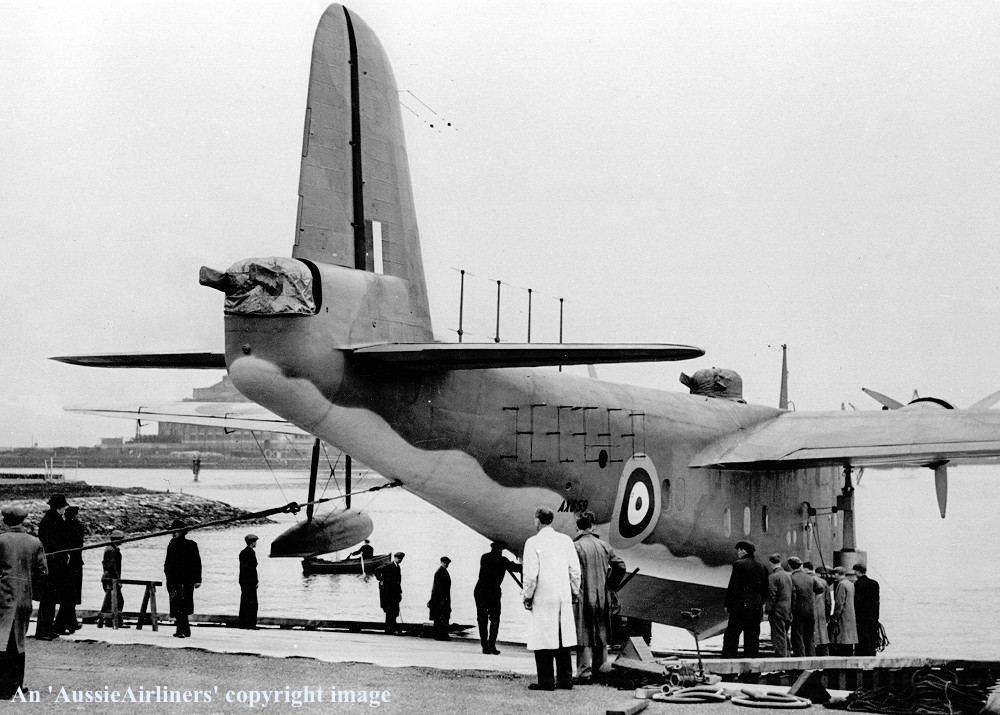G-AETY. Short S-23C Empire Class Flying Boat. c/n S.841.
This aircraft was the eighteenth Empire boat completed and flown by Short Bros at Rochester, Kent The order was placed by Imperial Airways, London - September 02, 1935 It was completed as an S-23 Empire Class boat having 920 h.p. Bristol Pegasus Xc engines The standard fuel capacity was 650 gallons It had an all-up weight of 40,500 lbs (18,380 kg) which was later increased to 53,000 lbs (24,200 kg) The cruising speed was 164 m.p.h. with a standard range of 760 miles / 1,245 km Entered onto the British Aircraft Register as G-AETY (CofR 7673) - March 01, 1937 Registered to Imperial Airways Limited, London First flown as G-AETY - July 28, 1937 Certificate of Airworthiness (CofA 5994) issued - July 30, 1937 Delivered to Imperial Airways, London - July 30, 1937 The aircraft was named 'Clio' Operated its first service on the Southampton - Alexandria route as IE571 - August 01, 1937 The 'IE' designation indicates the aircraft was flying the east-bound service Operated first service on the Alexandria - Southampton route as IW569 - August 03, 1937 The 'IW' designation indicates the aircraft was flying the west-bound service This aircraft was part of the aircraft pool operated by Imperial Airways and Qantas Empire Airways on services between Southampton, England and Sydney, Australia Qantas Empire Airways crews flew the aircraft on the Sydney - Singapore - Sydney sector of this route between July 1938 and October 1941 Qantas Empire Airways crews then took over the Singapore - Karachi - Singapore sector of the route from October 1941 to February 1942 when operations ceased due to Japanese war activities in South-East Asia This aircraft was acquired by British Overseas Airways Corporation (B.O.A.C.) when it merged with Imperial Airways of London - April 01, 1940 Registered to British Overseas Airways Corporation, Bristol - August 22, 1940 Commandeered by the Royal Air Force for use by Coastal Command Returned to Short Brothers and Harland at Belfast - July 09, 1940 This aircraft had flown 4,382 hours during its civilian life It was modified to incorporate an array of A.S.V. aerials on the fuselage Two Boulton & Paul A-type 'four-gun' gun turrets were fitted - one amidship and the other in the tail The rudder was cropped at its lower end to accommodate the turret Armour plating was fitted to vital points around the flight deck and fuel tanks The modifications were carried out between September 1940 and March 1941 It was relaunched as 'AX-659' - March 12, 1941 Allotted to No.119 Squadron R.A.F. where it took part in long range reconnaissance patrols between the Isle of Islay and Iceland The aircraft was also utilised to transport supplies to R.A.F. units in the Shetlands, Orkneys and Hebrides This aircraft was lost when it crashed into the sea off Lochindaal, Isle of Islay, Scotland - August 22, 1941 It had flown some 4,604 hours |
 |
G-AETY. Imperial Airways London - 'Clio' in the standard livery at Rochester, Kent, July 1937. (R. N. Smith Collection Copyright Image 2545-267.) |
 |
G-AETY. Imperial Airways London - 'Clio' in the standard livery at Rose Bay, Sydney, circa 1938. (P. Sheehan Collection Copyright Image 2545-847.) |
 |
G-AETY & VH-ABA. Imperial Airways London 'Clio' and Qantas Empire Airways 'Carpentaria' in the standard livery at Southampton, date unknown. (R. N. Smith Collection Copyright Image 2545-351.) |
 |
G-AETY. Imperial Airways London - 'Clio' in the standard wartime livery at Queens Island, Belfast, September 1940. (P. Sheehan Collection Copyright Image 2545-880.) |
 |
AX659. Royal Air Force - in the standard wartime livery at Queens Island, Belfast, March 1941. (P. Sheehan Collection Copyright Image 2545-848.) |
 |
AX659. Royal Air Force - in the standard wartime livery at Queens Island, Belfast, March 12, 1941. (P. Sheehan Collection Copyright Image 2545-849.) |